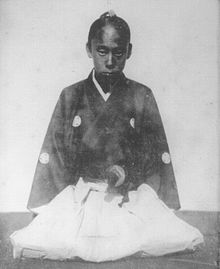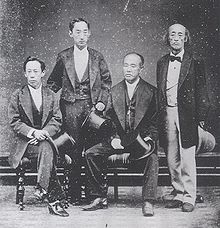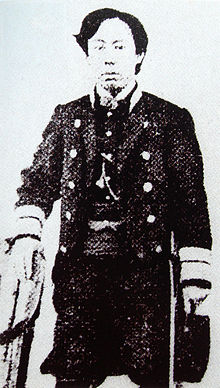- Matsudaira Sadaaki
-
Matsudaira Sadaaki 
A young Matsudaira Sadaaki 4th (Matsudaira) Lord of Kuwana In office
1859–1868Preceded by Matsudaira Sadamichi Succeeded by Matsudaira Sadanori 56th Kyoto Shoshidai In office
1864–1867Preceded by Inaba Masakuni Succeeded by none Personal details Born January 18, 1847
Edo, JapanDied July 12, 1908 (aged 61) Nationality Japanese Spouse(s) Matsudaira Hatsuko Matsudaira Sadaaki (松平 定敬, January 18, 1847 – July 12, 1908) was a Japanese daimyo of the Bakumatsu period, who was the last ruler of the Kuwana Domain. Sadaaki was the adopted heir of Matsudaira Sadamichi, the descendant of Sadatsuna, the third son of Hisamatsu Sadakutsu (1569-1623), who was Tokugawa Ieyasu's brother. His family was known as the Hisamatsu Matsudaira clan. It was to this family that Matsudaira Sadanobu also belonged.[1]
Contents
Biography
Matsudaira Tetsunosuke (the future Sadaaki) was born at Ichigaya in Edo, the 8th son of Matsudaira Yoshitatsu, the lord of the Takasu domain. One of his older brothers was Matsudaira Katamori, who later became the lord of Aizu. In 1859, Tetsunosuke was adopted to succeed the newly deceased Matsudaira Sadamichi as lord of the Kuwana Domain. He was betrothed to Sadamichi's 3 year old daughter Hatsu, thus formalizing the adoption. Coming of age, he took the name Sadaaki.
Sadaaki was the Tokugawa shogunate's last Kyoto shoshidai in the period spanning May 16, 1864 through January 3, 1868.[2] As shoshidai, he supported his brother's work in Kyoto as the Kyoto protector. In 1864, Sadaaki deployed Kuwana troops as part of the shogunate's effort to subdue the Tengu-tō's uprising.
During these years Sadaaki was famous as an avid horseman, and received an imported Arabian horse as a gift from the Shogunate.
 The "Four Brothers of Takasu." Left to right: Matsudaira Sadaaki, Matsudaira Katamori, Tokugawa Mochinaga, and Tokugawa Yoshikatsu
The "Four Brothers of Takasu." Left to right: Matsudaira Sadaaki, Matsudaira Katamori, Tokugawa Mochinaga, and Tokugawa Yoshikatsu
Sadaaki fought in the Boshin War (1868-1869), leading Kuwana forces during the fighting in northern Japan. He was together with Katamori until the start of the siege of Aizu, when Katamori asked him to leave and seek reinforcements from the other clans of the Northern Alliance.[3] Sadaaki followed his brother's advice and headed for the Yonezawa Domain.[3] After the fall of Yonezawa and the defeat of the Alliance, Sadaaki embarked on Enomoto Takeaki's warships at Matsushima Bay, and went on to the Ezo Republic.[4] He was brought to Yokohama at the war's end, where he formally surrendered. After a few years in confinement, he was pardoned and released in 1872. It was soon after his release that he finally married Matsudaira Hatsu, who had just turned 16.
Sadaaki joined the Imperial Japanese Army during the Satsuma Rebellion, leading a group of former Kuwana samurai and heading for Kyūshū. Later in life, he served as one of the head priests of Tōshōgū Shrine, along with his brother Katamori, and his brother's former chief karō, Saigō Tanomo. He also lived in Tokyo for some time, and had an avid interest in music; Clara Whitney, an American resident of Tokyo, notes in her diary that he was a skilled organ player.
Sadaaki and Hatsu had two children, Toshi and Masao, both of whom died in infancy. However, Sadaaki also had a concubine; it was this concubine who bore him a son (Sadaharu) who survived to adulthood. He also had a daughter by another woman; this daughter married Sakai Tadakazu.
Sadaaki died at age 61, and is buried in the Somei Cemetery in Tokyo.
In Fiction
Matsudaira Sadaaki has appeared as a character in many works of fiction, usually in works about his brother and Aizu. In the 1987 TV miniseries Byakkotai, he was portrayed by Hashinosuke Nakamura.[5] In NHK's 1998 Taiga drama Tokugawa Yoshinobu, Jō Watanabe portrayed him.[5]. He also appears briefly in episode 7 of the anime Clockwork Fighters, Hiwou's war.
References
- ^ Papinot, Jacques. (2003). Nobiliare du Japon -- Matsudaira (Hisamatsu), p. 32; Papinot, Jacques Edmond Joseph. (1906). Dictionnaire d’histoire et de géographie du Japon. (in French/German).
- ^ Meyer, Eva-Maria. "Gouverneure von Kyôto in der Edo-Zeit." Universität Tübingen (in German).
- ^ a b Yamakawa, Kenjirō (1933). Aizu Boshin Senshi. p. 523.
- ^ Yamakawa, p. 505.
- ^ a b "Matsudaira sono ichi"
- Meyer, Eva-Maria. (1999). Japans Kaiserhof in de Edo-Zeit: Unter besonderer Berücksichtigung der Jahre 1846 bis 1867. Münster: Tagenbuch. ISBN 3-8258-3939-7
- Papinot, Jacques Edmund Joseph. (1906) Dictionnaire d'histoire et de géographie du japon. Tokyo: Librarie Sansaisha...Click link for digitized 1906 Nobiliaire du japon (2003)
- Sasaki Suguru. (2002). Boshin sensō: haisha no Meiji ishin. Tokyo: Chūōkōron-shinsha.
- Tsunabuchi Kenjō (1984). Matsudaira Katamori no subete. Tokyo: Shin Jinbutsu Ōraisha.
- Whitney, Clara (1979). Clara's diary: an American girl in Meiji Japan. Ed. M. William Steele and Tamiko Ichimata. Tokyo/New York: Kodansha International.
- Yamakawa Kenjirō (1933). Aizu Boshin Senshi. Tokyo: Tokyo Daigaku Shuppankai.
- (Japanese) "Matsudaira Sadaaki" on bakusin.com (28 Feb. 2008)
- (Japanese) "Matsudaira sono ichi" on Taiga dorama & jidaigeki tojōjinbutsu haiyaku jiten (28 Feb. 2008)
Further reading
- --- (1998). Matsudaira Sadaaki no Subete. Tokyo: Shin Jinbutsu Ōraisha.
- Totman, Conrad (1980). Collapse of the Tokugawa Bakufu, 1862-1868. Honolulu: University of Hawai'i Press.
External links
- (Japanese) "Matsudaira Sadaaki ga mita Kuwana wo aruku"
- (Japanese) Pictures from the Kuwana-Matsudaira family graves at Somei Cemetery, including Sadaaki's
Preceded by
Matsudaira Sadamichi4th (Matsudaira) Lord of Kuwana
1859-1868Succeeded by
Matsudaira SadanoriPreceded by
Inaba Masakuni56th Kyoto Shoshidai
1864-1867Succeeded by
noneTokugawa Officials Shogun Tokugawa Ieyasu (1603–1605) · Tokugawa Hidetada (1605–1623) · Tokugawa Iemitsu (1623–1651) · Tokugawa Ietsuna (1651–1680) · Tokugawa Tsunayoshi (1680–1709) · Tokugawa Ienobu (1709–1712) · Tokugawa Ietsugu (1713–1716) · Tokugawa Yoshimune (1716–1745) · Tokugawa Ieshige (1745–1760) · Tokugawa Ieharu (1760–1786) · Tokugawa Ienari (1787–1837) · Tokugawa Ieyoshi (1837–1853) · Tokugawa Iesada (1853–1858) · Tokugawa Iemochi (1858–1866) · Tokugawa Yoshinobu (1867–1868)Tairō Sakai Tadayo (1636) · Doi Toshikatsu (1638-1644) · Sakai Tadakatsu (1638-1656) · Sakai Tadakiyo (1666-1680) · Ii Naozumi (1668-1676) · Hotta Masatoshi (1681-1684) · Ii Naooki (1696-1700, 1711-1714) · Yanagisawa Yoshiyasu (1706-1709) · Ii Naoyuki (1784-1787) · Ii Naoaki (1835-1841) · Ii Naosuke (1858-1860) · Sakai Tadashige (1865)
Rōjū Ōkubo Tadachika (1593-1614) · Ōkubo Nagayasu (1600-1613) · Honda Masanobu (1600-1615) · Naruse Masanari (1600-1616) · Andō Naotsugu (1600-1616) · Honda Masazumi (1600-1622) · Naitō Kiyonari (1601-1606) · Aoyama Tadanari (1601-1606) · Aoyama Narishige (1608-1613) · Sakai Tadatoshi (1609-1627) · Sakai Tadayo (1610-1634) · Doi Toshikatsu (1610-1638) · Andō Shigenobu (1611-1621) · Naitō Kiyotsugu (1616-1617) · Aoyama Tadatoshi (1616-1623) · Inoue Masanari (1617-1628) · Nagai Naomasa (1622-1633) · Abe Masatsugu (1623-1626) · Inaba Masakatsu (1623-1634) · Naitō Tadashige (1623-1633) · Sakai Tadakatsu (1624-1638) · Morikawa Shigetoshi (1628-1632) · Aoyama Yukinari (1628-1633) · Matsudaira Nobutsuna (1632-1662) · Abe Tadaaki (1633-1666) · Hotta Masamori (1635-1651) · Abe Shigetsugu (1638-1651) · Matsudaira Norinaga (1642-1654) · Sakai Tadakiyo (1653-1666) · Inaba Masanori (1657-1681) · Kuze Hiroyuki (1663-1679) · Itakura Shigenori (1665-1668, 1670-1673) · Tsuchiya Kazunao (1665-1679) · Abe Masayoshi (1673-1676) · Ōkubo Tadatomo (1677-1698) · Hotta Masatoshi (1679-1681) · Doi Toshifusa (1679-1681) · Itakura Shigetane (1680-1681) · Toda Tadamasa (1681-1699) · Abe Masatake (1681-1704) · Matsudaira Nobuyuki (1685-1686) · Tsuchiya Masanao (1687-1718) · Ogasawara Nagashige (1697-1705, 1709-1710) · Akimoto Takatomo (1699-1707) · Inaba Masamichi (1701-1707) · Honda Masanaga (1704-1711) · Ōkubo Tadamasu (1705-1713) · Inoue Masamine (1705-1722) · Abe Masataka (1711-1717) · Kuze Shigeyuki (1713-1720) · Matsudaira Nobutsune (1714-1716) · Toda Tadazane (1714-1729) · Mizuno Tadayuki (1717-1730) · Andō Nobutomo (1722-1732) · Matsudaira Norisato (1723-1745) · Matsudaira Tadachika (1724-1728) · Ōkubo Tsuneharu (1728) · Sakai Tadaoto (1728-1735) · Matsudaira Nobutoki (1730-1744) · Matsudaira Terusada (1730-1745) · Kuroda Naokuni (1732-1735) · Honda Tadanaga (1734-1746) · Toki Yoritoshi (1742-1744) · Sakai Tadazumi (1744-1749) · Matsudaira Norikata (1745-1746) · Hotta Masasuke (1745-1761) · Nishio Tadanao (1746-1760) · Honda Masayoshi (1746-1758) · Matsudaira Takechika (1746-1779) · Sakai Tadayori (1749-1764) · Matsudaira Terutaka (1758-1781) · Inoue Masatsune (1760-1763) · Akimoto Sumitomo (1747-1764, 1765-1767) · Doi Toshitsura (1838-1844) · Inoue Masaharu (1840-1843) · Andō Nobumasa (1860-1862) · Itakura Katsukiyo (1862-1864, 1865-1868) · Inoue Masanao (1862-1864) · Mizuno Tadakiyo (1862-1866) · Sakai Tadashige (1863-1864) · Arima Michizumi (1863-1864) · Makino Tadayuki (1863-1865) · Matsumae Takahiro (1864-1865) · Abe Masato (1864-1865) · Suwa Tadamasa (1864-1865) · Inaba Masakuni (1864-1865, 1866-1868) · Matsudaira Munehide (1864-1866) · Inoue Masanao (1865-1867) · Matsudaira Yasuhide (1865-1868) · Mizuno Tadanobu (1866) · Matsudaira Norikata (1866-1868) · Inaba Masami (1866-1868) · Matsudaira Sadaaki (1867) · Ōkōchi Masatada (1867-1868) · Sakai Tadatō (1867-1868) · Tachibana Taneyuki (1868)
Wakadoshiyori Nagai Naoyuki (1867-1868) ·
Kyoto shoshidai Okudaira Nobumasa (1600-1601) · Itakura Katsushige (1601-1619) · Makino Chikashige (1654-1668) · Itakura Shigenori (1668-1670) · Nagai Naotsune (1670-1678) · Toda Tadamasa (1678-1681) · Inaba Masamichi (1681-1685) · Tsuchiya Masanao (1685-1687) · Naitō Shigeyori (1687-1690) · Matsudaira Nobuoki (1690-1691) · Ogasawara Nagashige (1691-1697) · Matsudaira Nobutsune (1697-1714) · Mizuno Tadayuki (1714-1717) · Matsudaira Tadachika(1717-1724) · Makino Hideshige (1724-1734) · Toki Yoritoshi {1734-1742) · Makino Sadamichi (1742-1749) · Matsudaira Sukekuni (1749-1752) · Sakai Tadamochi (1752-1756) · Matsudaira Terutaka(1756-1758) · Inoue Masatsune (1758-1760) · Abe Masasuke (1760-1764) · Abe Masachika (1764-1768) · Doi Toshisato (1769-1777) · Kuze Hiroakira (1777-1781) · Makino Sadanaga (1781-1784) · Toda Tadatō (1784-1789) · Ōta Sukeyoshi (1789-1782) · Hotta Masanari (1792-1798) · Makino Tadakiyo (1798-1801) · Doi Toshiatsu (1801-1802) · Aoyama Tadayasu (1802-1804) · Inaba Masanobu (1804-1806) · Abe Masayoshi (1806-1808) · Sakai Tadayuki (1808-1815) · Ōkubo Tadazane (1815-1818) · Matsudaira Norihiro (1818-1823) · Naitō Nobuatsu (1823-1825) · Matsudaira Yasutō (1825-1826) · Mizuno Tadakuni (1826-1828) · Matsudaira Muneakira (1828-1832) · Ōta Sukemoto (1832-1834) · Matsudaira Nobuyori (1834-1837) · Doi Toshitsura (1837-1838) · Manabe Akikatsu (1838-1840) · Makino Tadamasa (1840-1843) · Sakai Tadaaki (1843-1850) · Naitō Nobuchika (1850-1851) · Wakisaka Yasuori (1851-1857) · Honda Tadamoto (1857-1858) · Sakai Tadaaki (1858-1862) · Matsudaira Munehide (1862) · Makino Tadayuki (1862-1863) · Inaba Masakuni (1863-1864) · Matsudaira Sadaaki (1864-1867)
Bugyō Bugu-bugyō (post-1863) · Edo machi-bugyō · Fushimi bugyō · Gaikoku-bugyō (post-1858) · Gunkan-bugyō (post-1859) · Gusoku-bugyō · Hakodate bugyō · Haneda bugyō (post-1853) · Hyōgo bugyō (post-1864) · Jisha-bugyō · Kanagawa bugyō (post-1859) · Kanjō-bugyō (post-1787) · Kinzan-bugyō · Kyoto machi-bugyō · Nara bugyō · Machi-bugyō · Nagasaki bugyō · Niigata bugyō · Nikkō bugyō · Osaka jōdai · Osaka machi-bugyō · Rōya-bugyō · Sado bugyō · Sakai bugyō · Sakuji-bugyō (post-1632) · Shimoda bugyō · Sunpu jōdai · Uraga bugyō · Yamada bugyō
Daimyo ·
Hatamoto ·
Ōmetsuke Yagyū Munenori (1632-1636) · Mizuno Morinobu (1632-1636) · Akiyama Masashige 1632-1640) · Inoue Masashige (1632-1658) · Kagazume Tadazumi (1640-1650) · Nakane Masamori (1650) · Hōjō Ujinaga (1655-1670) · Ōoka Tadatane (1670) · Nakayama Naomori (1684) · Sengoku Hisanao (1695-1719) · Shōda Yasutoshi (1699-1701) · Sakakibara Tadayuki (1836-1837) · Atobe Yoshisuke (1839-1841, 1855-1856) · Tōyama Kagemoto (1844) · Ido Hiromichi 1853-1855) · Tsutsui Masanori (1854-1857) · Ōkubo Tadahiro (1862) · Matsudaira Yasuhide (1864) · Nagai Naoyuki (1864-1865, 1865-1867) · Yamaoka Takayuki (1868) · Oda Nobushige (1868)
Metsuke ·
Kyoto Shugoshoku Matsudaira Katamori (1862-1864) · Matsudaira Yoshinaga (1864) · Matsudaira Katamori (1864-1867)
The several configurations of the Tokugawa shogunate's bureaucracy were changed according to perceived needs and conditions. Categories:- 1847 births
- 1908 deaths
- Daimyo
- People of the Boshin War
- Meiji Restoration
- Kannushi
- Kyoto Shoshidai
- Japanese Shintoists
- People from Tokyo
- Japanese musicians
- Tokugawa clan
- Shinpan daimyo
- Recipients of Japanese royal pardons
Wikimedia Foundation. 2010.

